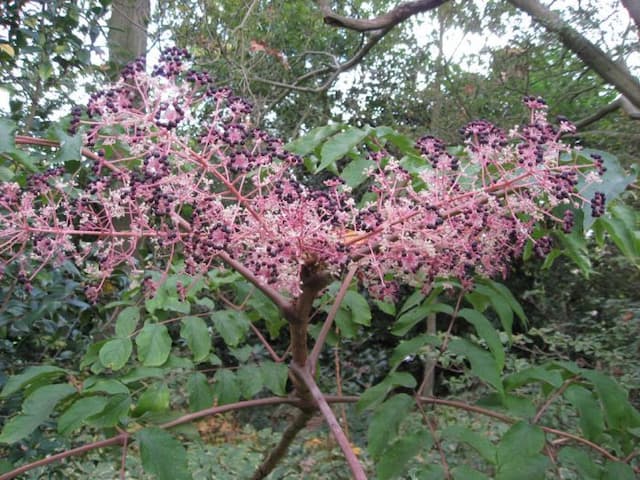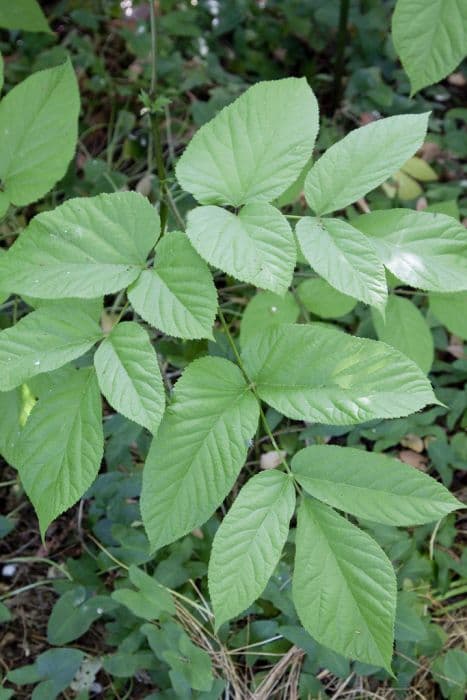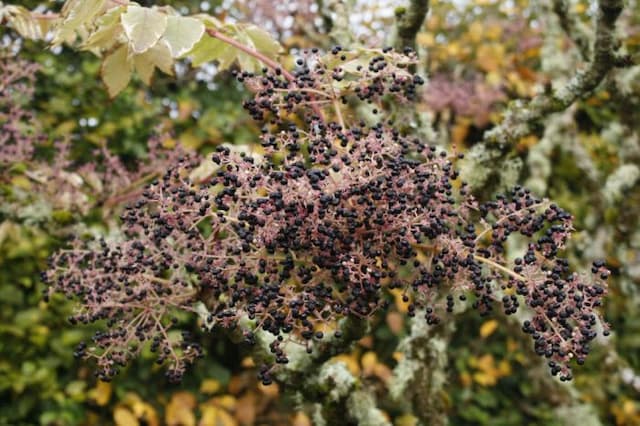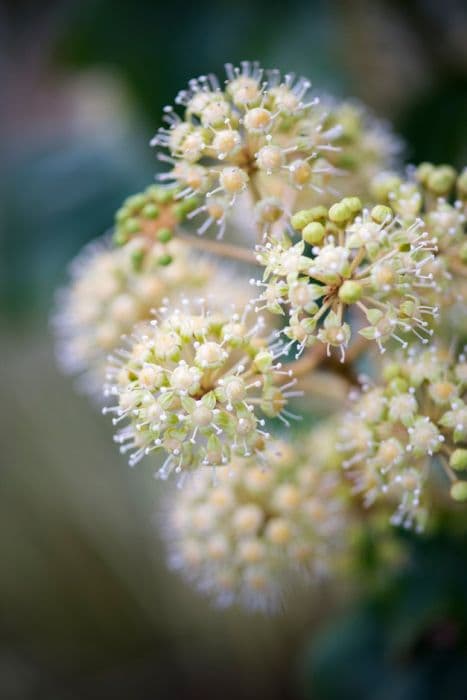Japanese Angelica Tree Aralia elata

ABOUT
The Japanese angelica tree is a deciduous shrub or small tree known for its lacy, finely divided leaves. Each leaf is large and compound, comprising multiple smaller leaflets arranged in a way that gives the whole leaf a feather-like appearance. The leaflets are somewhat elongated, with serrated edges, and green in color, turning to golden yellow or reddish hues in the fall before they drop. In late summer, the plant puts on a showy display with its large, pyramidal clusters of tiny white flowers. These blossoms are numerous and form an airy canopy above the foliage, attracting various pollinators while in bloom. After flowering, the plant produces purplish-black berries which are small and rounded, offering a source of food for wildlife, though they are not generally considered edible for humans due to their bitter taste. The bark of the Japanese angelica tree is gray to brown, with rough texture and ridges, giving it a somewhat rugged appearance. The branches are fairly stout and spread to form an open, airy crown, allowing dappled sunlight to filter through the leaves, creating an attractive play of light and shadows. Overall, the Japanese angelica tree is valued in landscaping for its fine-textured foliage, floral display, and ornamental berry production.
About this plant
 Names
NamesSynonyms
Japanese Angelica Tree, Korean Angelica Tree, Chinese Angelica Tree, Elate Spikenard, Devil's Walking Stick
Common names
Aralia japonica, Aralia dasyphylla, Dimorphanthus elatus, Dimorphanthus simonii, Kalopanax ricinifolius.
 Characteristics
CharacteristicsLife cycle
Perennials
Foliage type
Deciduous
Color of leaves
Green
Flower color
White
Height
20-40 feet (6-12 meters)
Spread
15-30 feet (4.5-9 meters)
Plant type
Shrub
Hardiness zones
4
Native area
Asia
Benefits
 General Benefits
General Benefits- Ornamental Appeal: Japanese angelica tree is often used in landscapes for its decorative foliage, large compound leaves, and showy inflorescences.
- Wildlife Habitat: Its flowers provide nectar for pollinators, while birds and other wildlife enjoy its berries.
- Shade Production: The tree can offer shade in gardens and parks due to its height and broad canopy.
- Soil Improvement: Aralia elata is known to help in soil improvement by adding organic matter through leaf litter.
- Cultural Significance: In some cultures, it is used in traditional festivals and decor.
- Windbreak: Can be planted in rows to serve as a wind-filtering hedge.
- Urban Tolerance: It has a level of tolerance to urban pollution, making it suitable for city environments.
- Biodiversity Support: It supports a range of insects and birds, thus fostering local biodiversity.
 Medical Properties
Medical Properties- Anti-inflammatory: Aralia elata has been used in traditional medicine for its potential anti-inflammatory effects.
- Antioxidant: The plant is believed to contain components that have antioxidant properties, which can help in fighting oxidative stress.
- Immunomodulatory: It may have effects on the immune system, possibly enhancing immune function.
 Air-purifying Qualities
Air-purifying QualitiesThis plant is not specifically known for air purifying qualities.
 Other Uses
Other Uses- Insect Attractant: Aralia elata is known to attract beneficial insects to the garden, especially pollinators like bees, due to its abundant flowering.
- Soil Improvement: When planted, this plant can help to improve soil quality over time by adding organic matter as its leaves fall and decompose.
- Bonsai: The tree form of Aralia elata can be trained into bonsai, providing a unique and challenging subject for enthusiasts to shape and display.
- Habitat for Wildlife: The dense foliage can provide cover and nesting sites for birds while its flowers and fruits offer a source of food.
- Photography Subject: The plant's distinctive architecture and seasonal changes provide great opportunities for photography throughout the year.
- Dye Production: Some parts of the plant may be used in the natural dyeing of fabrics, giving shades of green or yellow depending on the mordant.
- Living Fences: Aralia elata can be used to create living fences or hedgerows, providing a natural barrier that is both functional and aesthetically pleasing.
- Cultural Symbolism: In certain cultures, planting this species in gardens may bear cultural or symbolic significance, such as representing resilience or protection.
- Culinary Delicacy: In some regions, the young shoots of Aralia elata, known as 'dureup' in Korea, are collected and prepared as a wild-foraged delicacy.
- Education and Research: This species can serve as a subject in educational settings, including botany and horticulture studies, because of its distinctive features and adaptability.
Interesting Facts
 Feng Shui
Feng ShuiThe Japanese angelica tree is not used in Feng Shui practice.
 Zodiac Sign Compitability
Zodiac Sign CompitabilityThe Japanese angelica tree is not used in astrology practice.
 Plant Symbolism
Plant Symbolism- Resilience: Aralia elata, commonly known as Japanese angelica tree, has the ability to thrive in a variety of soils and conditions, symbolizing the ability to endure and adapt to life's challenges.
- Growth: With its rapid growth rate, the Japanese angelica tree represents personal development and the pursuit of one's aspirations.
- Protection: The thorns and robust nature of the plant suggest a symbol of safeguarding oneself and one’s loved ones against harm.
- Regeneration: As a plant that can rejuvenate after being cut back or damaged, it stands for recovery and the power of healing.
 Water
WaterThe Japanese angelica tree requires regular watering to maintain slightly moist soil, especially during its growing season in spring and summer. It is typically recommended to water this species once a week with around 1 to 1.5 gallons of water, depending on the size of the plant and the weather conditions. During the fall and winter months, reduce the frequency to every two weeks as the tree enters a dormant phase and uses less water. It’s essential to avoid overwatering to prevent root rot – if the top inch of soil feels dry, it’s time to water the plant. Ensure the pot has adequate drainage to allow excess water to escape.
 Light
LightThe Japanese angelica tree thrives best in partial shade to full sun exposure. It should be placed in a spot where it can receive at least 4 to 6 hours of sunlight daily. Morning sunlight with afternoon shade is ideal to prevent heat stress during the hottest part of the day. Avoid placing it in deep shade as this can lead to poor foliage development and decreased vigor.
 Temperature
TemperatureThe Japanese angelica tree is hardy and can tolerate a range of temperatures, flourishing in conditions between 60°F and 80°F. It can withstand minimum temps down to around 40°F but should be protected from frost and extremely cold temperatures below this range. During the summer, make sure it’s not exposed to prolonged periods above 90°F, as extreme heat can stress the plant.
 Pruning
PruningPrune the Japanese angelica tree to maintain shape and remove any dead or damaged branches, which will encourage healthy growth and air circulation. The best time to prune is late winter or early spring, just before new growth begins. Perform light pruning annually, but for more extensive shaping or to control size, prune every 2 to 3 years. Always use clean, sharp pruning tools to make smooth cuts.
 Cleaning
CleaningAs needed
 Soil
SoilJapanese Angelica Tree thrives in a moist, well-draining soil mix with compost and perlite. The ideal soil pH should be between 5.5 and 6.5 for this plant.
 Repotting
RepottingThe Japanese Angelica Tree should be repotted every 2-3 years or when it becomes root-bound to ensure continued growth.
 Humidity & Misting
Humidity & MistingJapanese Angelica Tree prefers high humidity levels, ideally between 60% and 75% for optimal growth.
 Suitable locations
Suitable locationsIndoor
Place Japanese Angelica Tree in bright, indirect light indoors.
Outdoor
Plant Japanese Angelica Tree in partial shade outdoors.
Hardiness zone
4-9 USDA
 Life cycle
Life cycleAralia elata, commonly known as Japanese angelica tree, typically begins its life cycle with the germination of seeds which usually requires a period of cold stratification. Following germination, the seedlings establish themselves and grow into young plants. This stage is characterized by the development of a woody stem and compound leaves. As the plant enters maturity, it produces inflorescences, which are large, showy clusters of small white flowers, typically in the late summer. After pollination, which is often facilitated by insects, the flowers develop into small, dark purple to black fruits (drupes) that are consumed and disseminated by birds, allowing for seed dispersal. The plant continues to grow and can reach a large size, flowering annually and producing seeds to complete its reproductive cycle.
 Propogation
PropogationPropogation time
Spring-summer
Propogation: Japanese angelica tree, or Aralia elata, is commonly propagated through seeds, although it can also be propagated by root cuttings. The most popular method by far is seed propagation, which should be carried out in the fall when the seeds are ripe. Fresh seeds can be sown directly into a prepared seedbed outdoors. Stratification of seeds at 41 degrees Fahrenheit (5 degrees Celsius) for 90-120 days can improve germination. After stratification, seeds can be sown in the spring in a cold frame. Seedlings usually require a few years of growth before they are ready to be transplanted to their permanent location. Care should be taken to keep the soil consistently moist but not waterlogged, and seedlings should be protected from extreme weather conditions.









